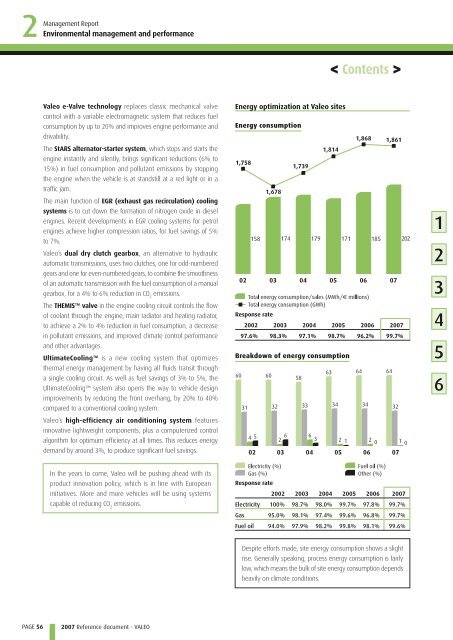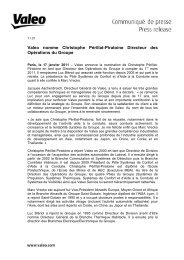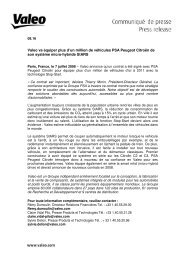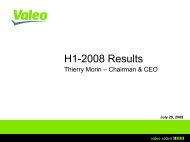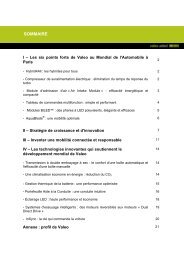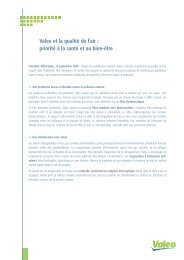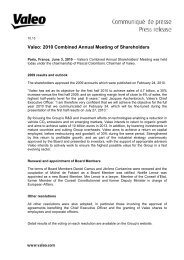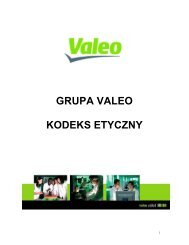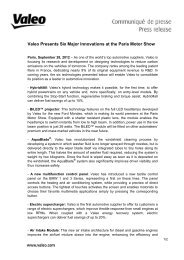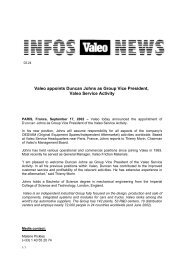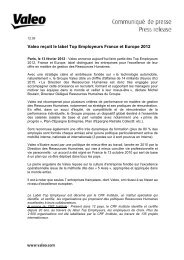2007 Reference document (PDF) - Valeo
2007 Reference document (PDF) - Valeo
2007 Reference document (PDF) - Valeo
Create successful ePaper yourself
Turn your PDF publications into a flip-book with our unique Google optimized e-Paper software.
2 Management<br />
PAGE 56<br />
Report<br />
Environmental management and performance<br />
<strong>Valeo</strong> e-Valve technology replaces classic mechanical valve<br />
control with a variable electromagnetic system that reduces fuel<br />
consumption by up to 20% and improves engine performance and<br />
drivability.<br />
The StARS alternator-starter system, which stops and starts the<br />
engine instantly and silently, brings significant reductions (6% to<br />
15%) in fuel consumption and pollutant emissions by stopping<br />
the engine when the vehicle is at standstill at a red light or in a<br />
traffic jam.<br />
The main function of EGR (exhaust gas recirculation) cooling<br />
systems is to cut down the formation of nitrogen oxide in diesel<br />
engines. Recent developments in EGR cooling systems for petrol<br />
engines achieve higher compression ratios, for fuel savings of 5%<br />
to 7%.<br />
<strong>Valeo</strong>’s dual dry clutch gearbox , an alternative to hydraulic<br />
automatic transmissions, uses two clutches, one for odd-numbered<br />
gears and one for even-numbered gears, to combine the smoothness<br />
of an automatic transmission with the fuel consumption of a manual<br />
gearbox, for a 4% to 6% reduction in CO emissions.<br />
2<br />
The THEMIS valve in the engine cooling circuit controls the flow<br />
of coolant through the engine, main radiator and heating radiator,<br />
to achieve a 2% to 4% reduction in fuel consumption, a decrease<br />
in pollutant emissions, and improved climate control performance<br />
and other advantages.<br />
UltimateCooling is a new cooling system that optimizes<br />
thermal energy management by having all fluids transit through<br />
a single cooling circuit. As well as fuel savings of 3% to 5%, the<br />
UltimateCooling system also opens the way to vehicle design<br />
improvements by reducing the front overhang, by 20% to 40%<br />
compared to a conventional cooling system.<br />
<strong>Valeo</strong>’s high-efficiency air conditioning system features<br />
innovative lightweight components, plus a computerized control<br />
algorithm for optimum efficiency at all times. This reduces energy<br />
demand by around 3%, to produce significant fuel savings.<br />
In the years to come, <strong>Valeo</strong> will be pushing ahead with its<br />
product innovation policy, which is in line with European<br />
initiatives. More and more vehicles will be using systems<br />
capable of reducing CO emissions.<br />
2<br />
<strong>2007</strong> <strong>Reference</strong> <strong>document</strong> - VALEO<br />
Energy optimization at <strong>Valeo</strong> sites<br />
Energy consumption<br />
Response rate<br />
2002 2003 2004 2005 2006 <strong>2007</strong><br />
97.6% 98.3% 97.1% 98.7% 96.2% 99.7%<br />
Breakdown of energy consumption<br />
< Contents ><br />
Response rate<br />
2002 2003 2004 2005 2006 <strong>2007</strong><br />
Electricity 100% 98.7% 98.0% 99.7% 97.8% 99.7%<br />
Gas 95.0% 98.1% 97.4% 99.6% 96.8% 99.7%<br />
Fuel oil 94.0% 97.9% 98.2% 99.8% 98.1% 99.6%<br />
Despite efforts made, site energy consumption shows a slight<br />
rise. Generally speaking, process energy consumption is fairly<br />
low, which means the bulk of site energy consumption depends<br />
heavily on climate conditions.<br />
1<br />
2<br />
3<br />
4<br />
5<br />
6


